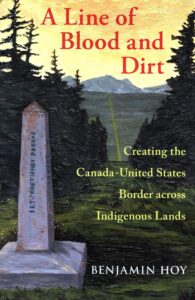Book review: A Line of Blood and Dirt: Creating the Canada-United States Border Across Indigenous Lands
 Reviewed by Karl Hele
Benjamin Hoy’s A Line of Blood and Dirt: Creating the Canada-United States Border Across Indigenous Lands is a marvellous easy-to-follow examination of the Canadian-American borderlands from the Great Lakes to the Pacific Ocean from the 1870s to the 1930s. It is a well-written and enjoyable narrative of how Canada and the United States created an international border across a landscape already filled with Indigenous borders. A Line of Blood and Dirt shows how the “world’s longest undefended border” rests upon a foundation of violence, anxiety, and conflict. The border, as ably shown by Hoy, rests upon notions of a transnational brotherhood that is inseparable from colonialism, hunger, dispossession, and Indigenous politics (pp. 7-8). Importantly, the border was maintained via direct (border agents) and indirect (withholding of annuities) controls. This led to the border’s creation and individuals’ experiences being neither equal nor consistent (p.8) in the moment or across time.
Reviewed by Karl Hele
Benjamin Hoy’s A Line of Blood and Dirt: Creating the Canada-United States Border Across Indigenous Lands is a marvellous easy-to-follow examination of the Canadian-American borderlands from the Great Lakes to the Pacific Ocean from the 1870s to the 1930s. It is a well-written and enjoyable narrative of how Canada and the United States created an international border across a landscape already filled with Indigenous borders. A Line of Blood and Dirt shows how the “world’s longest undefended border” rests upon a foundation of violence, anxiety, and conflict. The border, as ably shown by Hoy, rests upon notions of a transnational brotherhood that is inseparable from colonialism, hunger, dispossession, and Indigenous politics (pp. 7-8). Importantly, the border was maintained via direct (border agents) and indirect (withholding of annuities) controls. This led to the border’s creation and individuals’ experiences being neither equal nor consistent (p.8) in the moment or across time.
Hoy particularly emphasizes how Indigenous peoples interacted with the border and its agents over time. By showing variation, the narrative illustrates that the creation of the border relied on First Nations and Métis porters and guides, as well as information about smugglers. It also shows how Indigenous peoples utilized the border beyond refuge from state policies. For instance, Canadian authorities half-heartedly welcomed the Lakota fleeing U.S. violence after the Battle of Little Bighorn in 1876. These individuals were viewed as ‘foreigners’ or ‘refugees’ and not entitled to the benefits of being ‘Canadian Indians’ for decades. Similarly, Hoy discusses how Cree and Métis peoples fled to the U.S. to avoid Canadian state violence in 1885 and were viewed as ‘foreigners’ in the U.S. Yet, the Lakota, Cree, and Métis were moving within Indigenous borders and territories while simultaneously utilizing the international border as a ‘wall’ that halted direct violence.
Meanwhile, Canada and the U.S. took advantage of the border to establish their claims to land. For example, Canada used U.S. violence, declining buffalo herds, and resultant hunger as a means to control First Nations, sign treaties, and impose civilization policies. Throughout the work, Hoy also shows that people continued to cross for family, business, work, pleasure, and spiritual reasons while contesting, supporting, or expressing ambivalence to the border’s presence. Yet, over time, the imposed colonial border disrupted Indigenous concepts of land, territory, and borders thereby disrupting a sense of shared community and spirituality. Hoy refers to Jim Windigo who noted that over time, communities across the border became less reciprocal in their relations and increasingly faced taxation or seizure of goods when crossing. Yet, Windigo does note that the border provided the Anishinaabeg during the Great Depression with an ability to find resources and work, denied to many others, thanks to the border. Windigo’s testimony shows the border’s increasing effects on identity and community while pointing out the ambiguity of the border’s power to limit individual and community movements.
Overall, Hoy presents the idea that the Canada-U.S. border appearing logical straightforward and peaceable is a recently cultivated perception. Throughout its history, the border comes more clearly into focus through its inconsistencies, impositions, contestations, and inequalities. What is clear is the centrality of Indigenous peoples to the development of the border. A Line of Blood and Dirt is a wonderful and engaging survey of the border’s creation and implementation that will hopefully inspire greater nuanced studies that have been generally lacking in the exploration of the Canadian-U.S. borderlands. This is a must-read for anyone wanting to understand the stretch and limit of state power along a border and its impact on peoples.
Benjamin Hoy, A Line of Blood and Dirt: Creating the Canada-United States Border Across Indigenous Lands. New York: Oxford University Press, 2021.
ISBN: 978-0197528693


